Steel City Builds Green
Air Date: Week of September 18, 2009
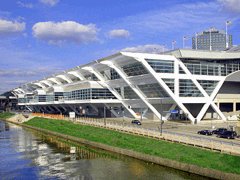
The leaders of the world’s largest economies will meet here at the G-20, in Pittsburgh’s David Lawrence Convention Center. It also happens to be the world’s first green-certified convention center.
A visit to Pittsburgh, the once unlikely host for a big G-20 summit. But the proud home of the US steel industry is now remaking itself with green buildings and clean tech jobs. Host Jeff Young finds out just how real the green revival is.
Transcript
YOUNG: It’s Living on Earth, I’m Jeff Young.
CURWOOD: And I’m Steve Curwood. Climate change will be high on the agenda when the G20 convenes in Pittsburgh. Hardly a world capital, and Jeff, you went to Steel Town to find out why that was chosen as the host city for the economic summit.
YOUNG: Yeah, you know this has been a bit of a puzzler from the moment White House Press Secretary Robert Gibbs made the announcement.
GIBBS: One quick announcement before we get started.
YOUNG: Now, just listen to the White House press corps reaction here.
GIBBS: The United States will host the next G20 summit in Pittsburgh, Pennsylvania.
[LAUGHS AND SHUFFLING FROM AUDIENCE]
YOUNG: Well, that chuckling didn’t go over so well in Steel Town.
LEAHY: Of course, the Pittsburghers, we’ve kinda got our backs up straight. It’s like, why’s they laughin’ at our community? So, why Pittsburgh? Well, as we look at it, why not Pittsburgh?
YOUNG: Mark Leahy is showing me around the facility he manages, Pittsburgh’s David Lawrence Convention Center. That’s where the G20 leaders will meet, and it happens to be the country’s largest certified green building, as a plaque on the wall proclaims.
LEAHY: That is our certification.
YOUNG: There—there—there it is. Tells you what it’s all about. U.S. Green Building Council gold standard?
LEAHY: Gold standard. LEED gold 2003: Leadership in Energy and Environmental Design. That is our pride and joy, right there.
YOUNG: Nearly every scrap from the Convention Center’s kitchens gets composted, gray water is reused, natural light from louvered windows floods the massive meeting rooms, and the soaring, sloping roof circulates the air.
LEAHY: So, imagine several thousand people in a convention center. I don’t have any air or chilling or anything going on, and no lights on, so the energy savings is just tremendous.
[SOUND OF TRUCKS MOVING]
YOUNG: And it’s not just the convention center. Pittsburgh ranks seventh in the country in the number of green buildings, thanks largely to its biggest bank: PNC.
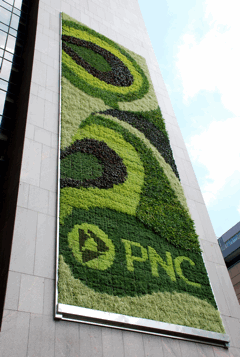
Pittsburgh’s biggest bank doesn’t just have green in its vaults. It has a fleet of LEED-certified green buildings and this “living wall.” (Courtesy of PNC)
YOUNG: Fred Solomon shows me PNC’s newest green buildings -- two high-rises, 64 green branch offices, and now, the country’s largest living wall: six stories of flowing, flowering greenery on display just in time for the G20 dignitaries.
SOLOMON: It’s not just the world’s leaders. It’ll be 3,000 journalists coming to Pittsburgh to see why Pittsburgh, why did the president pick this city? And we believe that our commitment to green, together with Pittsburgh’s history of overcoming difficult economic times, this was the can’t-miss location for the summit.
YOUNG: Take that, snickering press corps. This no rustbelt remnant. Pittsburgh’s steel helped build America, now the city’s rebuilding in green. Influential non-profits like the Heinz Foundation nudged the private sector toward efficiency and clean energy, and local government officials cleaned up old industrial sites for redevelopment.
Nearly one-third of the region’s technology jobs are now in green industries, and Pittsburgh’s research universities provide the creative juice for new green businesses. For a company called Plextronics it literally was juice.
[SOUND OF LIQUID SHAKING IN A JUG]
YOUNG: That liquid developed by a Carnegie Mellon professor is what Plextronics COO Glenn Thompson thinks could revolutionize the way we light our products and homes.
THOMPSON: You can hear it shaking here. The materials in here is one of the inks we would use produce, in this case, a light-emitting material – a light-emitting diode, for example.
YOUNG: Thompson showed me around the lab where 70 Plextronics employees develop printable circuitry. They hope to light consumer devices and generate solar power with inexpensive, non-toxic, thin films.
THOMPSON: The end of the day, you’ll see your television screen probably roll out of a tube some day and be pasted to your wall in your home. But white lighting is the real opportunity because we have the capability to then replace fluorescent and incandescent then with very low-cost, cool energy that can be driven by the photo cells that are on the outside of your building.
YOUNG: I’m wondering, growing up, did you ever dream that there would be something like this happening in Pittsburgh?
THOMPSON: Not in my wildest dreams, in all honesty. Uh, this was a steel town when I was a kid. It was dirty, it was very, very blue collar. I never dreamed that you’d see anything of this high technology come out of this area. It’s a real phoenix situation, it really is, it’s a rebirth.
YOUNG: It is remarkable that green has taken root in Pittsburgh at all considering its polluted past. Choking smoke shrouded the mill towns along the three river valleys. Nowhere did the smog take a greater toll than in the little town on Donora, just up the Monongahela River.
[SOUND OF PASSING TRAFFIC]
YOUNG: Among Donora’s vacant storefronts, there’s a new museum. It’s dedicated to the great smog of October 1948. Retired schoolteacher, Charles Stacy, remembers it well.
STACY: Oh, certainly I remember. I was a senior in high school at the time, and we had to walk to school through that. We couldn’t see the traffic signals, we couldn’t see the streetlights, and of course we had to be very careful that we didn’t fall off the curbs.
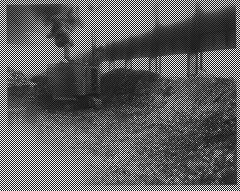
Pollution equaled progress for Pittsburgh and its mill towns, until the killer smog of 1948 took 20 lives in Donora. “We say clean air started here,” says Donora’s Charles Stacey. (Courtesy of the Donora Digital Collection)
STACY: Things got to be so bad that they had to make a temporary morgue on the lower floor because the funeral directors couldn’t handle all the bodies.
YOUNG: So, in the wake of this. I mean, people died, it was kind of hard to ignore the reality of it, but people still didn’t want to address it.
STACY: They didn’t wish to address it because this was their livelihood, and they would rather put up with the dirt and polluted air, and maybe poisons in the atmosphere, and so forth, just to maintain their jobs. And, we say that clean air started here and it focused attention on air pollution, but people died and we lost jobs, and the community is fallen on hard times as a result of that, and we hope that other communities learn their lessons from Donora.
YOUNG: In the sixties, Donora’s mills were among the first in the region to close. The closures continued through the seventies and eighties as the steel industry collapsed.
[SOUNDS OF STEEL MILLING]
YOUNG: You can still watch steel being made around here just a couple miles downriver from Pittsburgh in the town of Braddock where Lisa Roudabush is Mon Valley Works general manager for U.S. Steel.
ROUDABUSH: The Edgar Thompson Works was built in 1875. It was the first integrated steel facility in Pennsylvania. And right now, it’s the last operating steel facility in Pennsylvania. It’s pretty amazing –
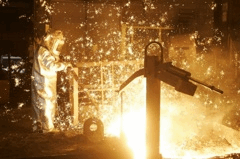
US Steel’s Edgar Thomson works is the last big steel mill in PA. Steel’s improved its energy efficiency and steelworkers hope their product will find new demand in clean energy products like wind turbines. (Courtesy of the World Steel Association)
ROUDABUSH: Well, we think steel is a very efficient material. We can make very lightweight cars out of steel. We do make the wind turbines out of steel. And I think steel is green.
YOUNG: Steel workers have embraced a green jobs agenda. The mayor of this mill town, John Fetterman, joins some steel workers for TV ads promoting a climate change bill.
[SLOW, SAD PIANO MUSIC]
FETTERMAN: We need a cap on carbon pollution. It’ll create jobs making things like solar panels and wind turbines. There’s 250 tons of steel in a wind turbine. You guys can handle that, right?
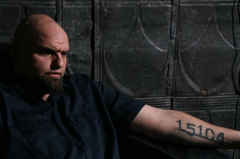
Wearing it on his sleeve: Braddock, Pa., Mayor John Fetterman has his town’s ZIP code tattooed to his arm. He’s hoping clean energy jobs will revive the economically distressed town.
FETTERMAN: Braddock is part of the fringe where unemployment consistently is above 30 percent, where we are the county’s poorest community.
YOUNG: You’d like to be working-class America but–
FETTERMAN: Absolutely. We—we someday aspire to be working-class America.
YOUNG: So, how real is this green thing that’s happening in Pittsburgh from your town’s perspective?
FETTERMAN: I think, you know, without trying to be negative in front of the G20, there’s a lot of great things to highlight about Pittsburgh, but I think it’s not a neat, you know, kind of Hollywood narrative where Pittsburgh gets its heart broken, loses a quarter of a million steel jobs, and now everything’s hunky-dory again. It really isn’t.

The leaders of the world’s largest economies will meet here at the G-20, in Pittsburgh’s David Lawrence Convention Center. It also happens to be the world’s first green-certified convention center.
[MUSIC: Johnny Hodges “Three And Six (aka Wounded Love)” from ‘Lush Life: The Billy Strayhorn Songbook’ (Verve Records - 1996)]
Links
The David Lawrence Convention Center’s approach to green management of a large public building
More on the killer smog of 1948 at the Donora Smog Museum
More on John Fetterman’s hardcore approach to urban renewal in Braddock, Pa.
Living on Earth wants to hear from you!
Living on Earth
62 Calef Highway, Suite 212
Lee, NH 03861
Telephone: 617-287-4121
E-mail: comments@loe.org
Newsletter [Click here]
Donate to Living on Earth!
Living on Earth is an independent media program and relies entirely on contributions from listeners and institutions supporting public service. Please donate now to preserve an independent environmental voice.
NewsletterLiving on Earth offers a weekly delivery of the show's rundown to your mailbox. Sign up for our newsletter today!
 Sailors For The Sea: Be the change you want to sea.
Sailors For The Sea: Be the change you want to sea.
 The Grantham Foundation for the Protection of the Environment: Committed to protecting and improving the health of the global environment.
The Grantham Foundation for the Protection of the Environment: Committed to protecting and improving the health of the global environment.
 Contribute to Living on Earth and receive, as our gift to you, an archival print of one of Mark Seth Lender's extraordinary wildlife photographs. Follow the link to see Mark's current collection of photographs.
Contribute to Living on Earth and receive, as our gift to you, an archival print of one of Mark Seth Lender's extraordinary wildlife photographs. Follow the link to see Mark's current collection of photographs.
 Buy a signed copy of Mark Seth Lender's book Smeagull the Seagull & support Living on Earth
Buy a signed copy of Mark Seth Lender's book Smeagull the Seagull & support Living on Earth

